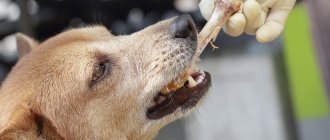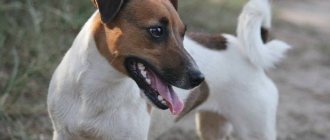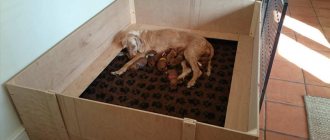Rat poisoning in dogs is less common than food poisoning or viral diseases of the gastrointestinal tract. The dose of toxic chemicals in rodent baits is small for the dog and due to this, timely treatment is always effective. The danger is that many owners cannot distinguish the signs of poisoning from other diseases or poisonings, and do not provide first aid correctly, and this can cause irreversible consequences in the pet’s body.
What is rat poison
The main component of rat poison is 1st or 2nd generation rodenticides, which are used to exterminate rodents (mice and rats) both in everyday life and in industrial and agricultural enterprises.
A dog can get poisoned while walking
Most of them are anticoagulants, which means that when they enter the blood they interfere with the synthesis of vitamin K. This leads to the fact that the blood can no longer clot, resulting in internal bleeding, which leads to death. Moreover, 1st generation rodenticides such as triphenacin and ethylphenacin have the ability to gradually accumulate in the animal’s body. They are excreted within 14-16 hours, provided that the dose of poison was low. Warfarin has a more persistent effect and therefore poses a greater danger to the pet.
Rat poison is a poisonous substance, any kind of it is dangerous for dogs
To exterminate warfarin-resistant rodents, a number of highly toxic drugs have been developed, such as bromadiolone, dicumarol, etc., which can remain in the body for up to 4-6 days, producing a pronounced toxic effect all this time. Such drugs belong to the 2nd generation rodenticides.
Another class of rat poisons, which includes naphthylthiocarbamide, can be considered the most effective in the fight against rodents. A toxic substance such as zinc phosphide is used if other means do not give the desired result. The drugs are used under strict control and in extremely low doses.
Important! If zinc phosphide enters an animal's body, it can lead to pulmonary edema. Even a tiny amount of this rat poison is a lethal dose for a dog.
Symptoms of poisoning with a product containing vitamin D3
Poisoning a dog with rat poison containing a large amount of vitamin D3, if left untreated for 2-3 days, causes kidney failure followed by death.
Symptoms:
- strong thirst;
- frequent urination;
- loss of appetite;
- unpleasant odor from the mouth, similar to the smell of stale urine;
- lethargic state.
There is no special antidote against this poison, but timely therapy, which can be carried out in a veterinary clinic, leads to complete recovery. Therapy includes the use of diuretics and drugs that quickly remove calcium from the body. Therapy is long-term, at least 1.5 months.
How can a dog get poisoned?
Why dogs can’t have chocolate: what to do if they eat it
Poisoning in pets occurs, as a rule, due to the carelessness of the owner. While walking, a dog may eat a poisoned mouse or simply stick its nose into a rat hole. Who is stopping her from drinking from a puddle next to the garbage containers where the bags with the remains of the poison were thrown?
If a dog is accustomed to taking food from the hands of others, it may be poisoned intentionally. There are many cases of mass extermination of stray dogs by scattering pieces of meat or sausage laced with rat poison. One of these tasty morsels may well be swallowed by a pet. There are a lot of options, and the most dangerous thing is that it is possible to identify what specific poison the animal was poisoned with only through laboratory tests.
Professional treatment
If the dog has eaten very little poison, and the poisoning has not progressed to a mild stage, inducing vomiting in the animal, sorbents and laxatives is usually sufficient. As a rule, these measures are enough for the dog to return to relative normality after a few hours. Well, after a few days, the symptoms of a dog being poisoned by rat poison will disappear completely.
In advanced cases, sometimes even a blood transfusion is required if the intoxication is too significant. Vitamin K is administered in this case by subcutaneous injection. Most likely, a dog with severe poisoning will require antibacterial treatment, as well as replenishment of iron deficiency in the body.
When an animal with poisoning arrives at the clinic, the veterinarian first conducts an external examination. In this case, the owner must tell the doctor as accurately and in detail as possible where and under what circumstances the dog tasted the poison, and mention all the symptoms that the animal experienced due to poisoning.
The dog is injected with vitamin K - this antidote is used for rodenticide poisoning. This is followed by symptomatic treatment, during which all the consequences of poisoning are systematically eliminated from the animal. To eliminate the consequences of intoxication, the veterinarian can use the following types of drugs:
- sorbents;
- salt-based laxative;
- painkillers if necessary;
- anti-inflammatory;
- diuretics;
- corticosteroids;
- cardiac drugs;
- antibiotics.
If a dog has tasted zinc phosphide, Maalox may be prescribed as treatment, which helps reduce the amount of toxins in the body and remove them out. The introduction of regular activated carbon and gastric lavage in several doses after this will also help the animal.
If the dog is in serious condition, he will most likely remain in the clinic for several days. If the dog’s condition is stable, after first aid is provided, it is discharged home with precise instructions for the owner of all subsequent steps: visits to the clinic, assistance, recommendations on diet, maintenance.
If the dog is severely poisoned, the course of treatment may take a month. Throughout this period, the animal is regularly administered an antidote in the form of vitamin K, and blood transfusions are given as necessary. Symptomatic treatment is carried out simultaneously with the main one.
Signs of rat poison poisoning in dogs
The effect of rat poison on the animal appears only on the 3-4th day, when the first alarming notes become noticeable, indicating signs of intoxication. This is due to the fact that vitamin K continues to fight toxins for some time. As long as there is enough of it in the body, the dog’s behavior does not differ from usual, but when the level of the vitamin drops sharply and its deficiency occurs, the following occur:
- temperature;
- weakness;
- drowsiness;
- dyspnea;
- bleeding from the anus, from the sinuses, from the gums;
- abdominal pain;
- blood in urine;
- refusal of food;
- loose stool.
How to understand that a dog is dying: signs of impending death
Such signs of malaise are typical for poisoning with 1st and 2nd generation rodenticides. Moreover, it all depends on the dose of the toxic substance taken. Cases have been recorded where dogs died within a day if they were not given emergency assistance.
Important! If you suspect poisoning with rat poison, you need to act immediately: provide first aid to your pet and take it to a veterinary hospital.
When exposed to such a strong poison as zinc phosphide, the symptoms of malaise are more pronounced. Signs of poisoning are:
- severe weakness;
- unsteadiness in movements;
- breathing problems;
- increased need to drink;
- convulsions;
- loose stools;
- short-term loss of consciousness.
The first signs appear on 3-4 days
Another toxic substance that causes cerebral edema in animals is bromethalin. The poison disrupts the activity of the nervous system. The first signs appear after 1.5-2 hours. Antidotes have not yet been found. Symptoms of intoxication are as follows:
- serious incoordination, limb failure;
- convulsions;
- muscle paralysis.
Bromethalin poisoning causes pulmonary edema
In case of naphthylthiocarbamide poisoning, the dog owner should be alert to:
- very weak pulse;
- lack of urination;
- gagging;
- difficulty breathing caused by pulmonary edema.
Insensitive people poison homeless stray dogs with anti-tuberculosis drugs, which can be easily purchased in pharmacies. Isoniazid in high doses is extremely dangerous. It is very quickly absorbed into the blood and after 2 hours reaches a maximum concentration that can kill an animal. Half an hour after administration, confusion, indifference to food, and drowsiness occur. The following symptoms appear:
- unsteadiness in movements;
- disturbances in the functioning of the limbs;
- vomit;
- heavy salivation;
- foam from the mouth;
- prolonged seizures that cannot be controlled with anticonvulsants;
- general weakness;
- internal bleeding;
- coma is possible.
Important! In case of isoniazid poisoning, emergency measures are required; dogs can rarely be saved if an antidote is not administered in a timely manner.
First aid kit
Experts have developed a special list of medications that should be in the home of every dog owner. Such items and medications will make the owner of a 4-legged friend fully prepared to provide first aid in case of poisoning. This list included:
- 3% peroxide solution;
- a set of syringes of different sizes, which are intended for washing the eyes;
- a rubber bulb necessary for cleaning the mouth;
- several packages of activated carbon;
- thermometer;
- numbers of veterinarians, emergency services for 4-legged animals.
First aid for rat poisoning
How to understand that a dog is pregnant: signs in the early stages
If the owner has suspicions that the dog has definitely eaten mouse poison, and all the symptoms confirm this, you need to act as if it was poisoned with the most powerful poison (isoniazid):
- Induce vomiting by sticking your hand into the mouth and placing table salt on the root of the tongue.
- Add vitamin B6 in a larger dosage than prescribed. It will not cause harm, but it will help save, since it is a good antidote. If there is no solution, you can replace the drug with activated carbon (at least 10 tablets).
And immediately to the veterinarian! Further treatment is carried out only in a clinical setting, based on the condition of the dog. Sometimes resuscitation measures are required - it all depends on the type of poison and its dose.
If you suspect poisoning, consult a doctor immediately
Antidote elements
When an animal is affected by anticoagulant elements, the only true salvation is the urgent administration of vitamin K1 - phytomenadione, which must be administered subcutaneously. The dosage depends entirely on the weight of the animal.
There is no specific antidote for rat infection. To save the victim, intensive tannin feeding is practiced. This element specifically binds all toxins in the stomach.
To save someone poisoned by a rat, you will need to immediately feed the victim with copper sulfate or soda.
In such a situation, it is extremely important to provide qualified assistance to the poisoned person in a timely manner. It is important to identify the type of poison and distinguish poisoning from hematological diseases. Only an experienced doctor can make a final diagnosis and prescribe adequate, comprehensive therapy.
Often, when blood vessels are damaged, doctors prescribe complex therapy. It includes:
- Long-term course of taking vitamin preparations with K1. The duration is sometimes up to 5 weeks. It all depends on the severity of the condition, data from objective examination methods and laboratory blood parameters.
- During the first hours after poisoning, it is advisable to perform a blood transfusion. In difficult situations, a transfusion is required for the dog. The technique allows you to restore the concentration of red blood cells and compensate for the deficiency of coagulation factors.
- We must not forget about symptomatic therapy: victims are always prescribed anticonvulsants and heart medications. If necessary, hepatoprotectors, diuretics and sorbents are added. The combination of medications is always selected individually - it all depends on the complexity of the condition and the body’s response to therapy.
Pet's diet after poisoning
Usually, after poisoning, the veterinarian gives recommendations on what to feed the pet during the rehabilitation period. Firstly, a dog’s weakened body cannot be overloaded with excess nutrition. On the first day they do not give food at all, only water. If a dog drinks a lot, that's good.
From the second day, low-fat broths, liquid porridges made from buckwheat, rice or oatmeal are included in the diet. Moreover, they are fed in small portions, 5-6 times a day.
The dog's diet after poisoning excludes the consumption of many foods
Porridge made from pearl barley, millet, semolina, any flour products, including bread and pasta, potatoes, dry food and any types of canned food are prohibited.
Anti-clotting drugs
Anti-clotting agents (LAACs) currently dominate the pest control market.
Mechanism of action. As you might guess, poison prevents blood from clotting. A rat or mouse that eats it ends its life from massive internal bleeding. The same can be said about poisoned dogs. In general, these compounds are completely similar in action (and sometimes in composition) to drugs actively used in medicine (for example, Warfarin (a natural vitamin K antagonist) or Coumadin®). Typically, in the case of dogs, the first symptoms are visible three to five days after poisoning. However, if the dog took a large “dose” at once, clinical signs will appear much earlier.
How to protect your dog from poisoning
Dogs that are not accustomed to following the basic “no” command, that do not disdain to pick up food from the ground, and that take food from the hands of strangers are always at risk. Therefore, having a muzzle and a leash during walks is completely justified.
Having a muzzle is completely justified
You should not walk with your pet near food factories, where rodents can be poisoned with potent poisons, near city landfills, large park recreation areas, where treats with a “secret” are often scattered, costing the pet’s life.
Taking care of the dog's health falls entirely on the owner's shoulders. To avoid absurd but dangerous accidents, you need to monitor the animal, and in case of poisoning, take emergency measures.
Precautionary measures
Unfortunately, in this case it is impossible to guarantee that your pet is completely safe. He can encounter poison anywhere. Try to walk with your dog, be sure to put a muzzle on it, and do not let it off the leash in places where cases of poisoning of pets have already been recorded.
Carefully follow the announcements of the local sanitary and epidemiological station: if they include rodent control, it is generally better to avoid walking with your dog. The consequences of poisoning are more severe after a week spent at home or in an enclosure.
Why is it dangerous?
Rat poison – Rat poison is one of the effective remedies to help get rid of various rodents. There are several types of poisonous agents.
Kinds:
- Instant poison. If it enters the rodent's body, death occurs quickly. The composition contains mummifying substances that turn the rodent into a mummy. The body slowly dries out and there is no unpleasant odor.
- Poison of gradual action. The poison kills within one to two weeks. The rodent dies from severe internal bleeding.
Rat poison is produced in the form of granules, powder, briquettes, tablets. Various flavorings are added to attract rodents.
The danger of the substance is its rapid impact on humans and animals. When working with such substances, you must follow the rules and use protective equipment.
Every owner should read and remember this!World has gone mad. Dog-hating is on the rise. The population poisons our dogs with impunity. On the dog hunter forums, recipes and methods on how to kill a dog are described in detail. They poison dogs with various nasty things, but two drugs are 100% lethal if adequate measures are not taken. These are isoniazid and rat poison (rodenticide).
I myself lost a gorgeous young dog who died because he stuck his nose into a rat hole treated with poison and then simply licked his lips. From the moment of the first symptoms to death, only 20 hours passed and all this time the dog was in the clinic... And then 10 years later, her great-niece died according to the same scenario in 22 hours and she spent almost all of this time in the clinic.
Treatment is possible and time is short, but there is. But there is no antidote, and the necessary drug is not certified in Russia. I know what to do with it and I want to share with you. But that’s not all, now there are also targeted baits in the form of meat balls or pieces of sausage stuffed with tablets used in the treatment of tuberculosis and sold in pharmacies without a prescription. When overdosed, these drugs rapidly cause seizures and death. And here there is a way out - there is even an antidote (antidote), but there is very little time!!! But! If you know what to do and have the necessary medications on hand, everything is not so hopeless!
So:
- How to manage to avoid poisoned traps?
- What to do if a dog swallows something on the street?
- What to do if your dog becomes ill and you suspect poisoning?
- Where to look for the necessary drugs. What you should have in your first aid kit.
The first is the most important!
You should always be able to see what your dog is doing at any time of the day while walking. You must teach your dog never to pick up anything from the ground, never to take anything from the hands of strangers! This is the basis of safety! This, no matter how nightmare it sounds, is the basis for the survival of our dogs in the city.
Second most important!
If you see that your dog ate something from the ground or took it and ate it from the hands of a stranger and you can assume that it is poison, then run home and urgently induce vomiting. If you rinsed the dog’s stomach within 15-30 minutes, then further therapy can only be preventive for self-soothing.
How to induce vomiting (gastric lavage).
Hydrogen peroxide is perhaps the best remedy. Mix hydrogen peroxide and water in equal parts and forcefully pour this mixture in the amount of one and a half tablespoons for every 4.5 kg of weight into the dog’s mouth. Vomiting will begin within a few minutes. This is what veterinarians advise. From actual practice, in some cases this amount may not be enough. That's why! We pour in enough so that vomiting begins immediately.
As an example, I can cite a 4.5-month-old Dalmatian puppy who, during a break in class, found and swallowed the whole body of a rat. We immediately poured diluted peroxide into it in the indicated dosage - the puppy slobbered, but did not give up the rat. After some time, they began to pour the solution into him without restriction, about 250 ml of the solution was poured in, and only then did he literally burp this rat like a fountain.
Third.
If your dog suddenly starts bleeding from the anus and vomiting blood and you assume that the dog might have eaten something on the street, run to the clinic. We assume the worst - we tell the doctor that it is possible poisoning with rodenticides (rat poison, coumarins). Urgently! We are looking for the drug vitamin K-1 (phytomenadione, konakion).
If your dog suddenly starts vomiting foam, excessive salivation, loss of coordination, convulsions, and you assume that he ate something on the street, then we assume the worst and begin measures as in the case of isoniazid poisoning. (see below.)
Fourth.
K-1 can be found in online pharmacies, but only injectable. There are no tablets in Russia! You can search on the PesiQ forum in the veterinary section. There are attached topics about this drug. For those who visit Europe, the easiest way is to bring K-1 from there; it is freely sold without a prescription in pharmacies, but also injections, tablets are available in Sweden and the Czech Republic - look for information on the forum.
The antidote to isoniazid is
(pyridoxine) is freely available at any pharmacy. We need ampoules. They cost pennies - just keep it in your first aid kit as a spare. Also, you should always have hydrogen peroxide in your first aid kit to induce vomiting.
And now about the details.
Isoniazid poisoning (the anti-tuberculosis drug is extremely toxic in large doses, it must be swallowed, it is scattered in the form of pieces of minced meat or sausage, if the dog only sniffs or even licks it, it will not be poisoned). Isoniazid is rapidly absorbed, mainly in the small intestine. Its serum concentration reaches a maximum 1-2 hours after administration.
Symptoms:
- Drowsiness, confusion - appear after 30-60 minutes.
- The dog begins to lose coordination, its legs give way, it skids to the sides
- Vomit
- Excessive salivation, foam at the mouth
- In severe poisoning, coma, respiratory depression, convulsions, and lactic acidosis are possible. Seizures are usually prolonged and are not controlled by anticonvulsants. If there are no seizures, then lactic acidosis does not occur. (Acidosis is the accumulation of negatively charged particles (anions) of acids in the blood and other tissues of the body; lactic acidosis is the accumulation of lactate).
Treatment:
1. First of all, immediately introduce vitamin B6! (It is an antidote! Sold freely in any pharmacy!) Intramuscularly, for small dogs, up to approximately 20 kg, about 4-5 ml. More than 20 kg approximately 6-7 ml. There is no need to worry about an overdose of this vitamin. In this situation, in the indicated dosages, it will not harm or kill the animal. It will be worse if you administer lower dosages than indicated, the animal may die.
2. Urgent measures are taken to remove the toxic substance from the gastrointestinal tract, i.e. induce vomiting (see above)
3. After vomiting, adsorbents (activated carbon, enteros gel, or 20 ml diluted Atoxil sorbent with a syringe - it is very powerful and relatively inexpensive compared to enterosgel (and more powerful in action than enterosgel). Isoniazid is well adsorbed.
After all this, urgently go to the clinic for further therapy and be sure to tell the vet what you did at what time in what quantity and what initially happened to the dog.
My comments.
The forums are teeming with descriptions of cases of isoniazid poisoning; almost none of the dogs were saved. Some felt sick while walking and in the conditions of the park there was simply nothing to induce vomiting, and there was no B6 at home. By the time we figured out what was what, by the time we got to the vet, there was no one to help. A close colleague’s dog died from poisoning within an hour and a half. I came back from a walk and started vomiting, so far this and that. It was too late. Don’t waste time - inject the antidote, and then you’ll figure out whether it was necessary or not!
Poisoning with rat poison (rodenticides) - only go to the clinic, urgently!!! If the symptoms are already obvious, if you only assume that the dog has swallowed/licked the poison, urgently lavage the stomach (induce vomiting).
ETIOLOGY
Most rodenticides are anticoagulants. There are 1st generation rodenticides (warfarin (zoocoumarin)) and 2nd generation rodenticides created to get rid of warfarin-resistant rodents (dicumarol, coumafuril, difenacoum, brodifacoum, coumatetralil, bromadiolone, etc.). As a rule, 2nd generation rodeticides have more pronounced toxicity and a longer elimination time (4-6 days versus 14 hours for warfarin).
The mechanism of action of most rodenticides is the inhibition of vitamin K, which is involved in the synthesis of coagulation factors. After entering the body, it takes some time until the body’s own reserves of vitamin K are exhausted, after which, when the synthesis of one’s own vitamin K ceases, a deficiency of coagulation factors gradually develops with all the ensuing consequences.
The typical time for the onset of clinical symptoms varies from 3 to 5 days after rodenticide enters the body.
CLINICAL PICTURE
The most common symptoms in descending order are (in descending order):
- Dyspnea
- Anemia
- Weakness
- Cough/hemoptysis
- Pallor
- Anorexia
- Nose bleed
- Bloody stool
- Vomit
- Lameness
- Subcutaneous hemorrhages
- Hematuria
- Syncope
- Abdominal pain
- Shiver
Diagnosis is based on anamnesis, the clinical symptoms described above, blood tests (anemia (regenerative and non-regenerative), thrombocytopenia, hypoproteinemia, increased alkaline phosphatase (due to hypoxia), possibly a slight increase in liver enzymes, a specific increase in prothrombin time and activated coagulation time and changes in other coagulogram parameters ).
DIFFERENTIAL DIAGNOSIS
Anticoagulant poisoning in dogs and cats should be differentiated from other possible causes of bleeding:
- DIC syndrome
- Hereditary deficiency of clotting factors
- Willerbrand's disease
- Thrombocytopenia or their functional disorders
- Liver diseases
- Canine ehrlichiosis
The response to trial therapy with vitamin K1 allows us to differentiate most of the pathologies listed above.
TREATMENT
It largely depends on the stage at which the patient is delivered to the clinic. In case the poison was eaten a few minutes/hours ago, the necessary actions include a standard decontamination procedure.
Those. induce vomiting and then prescribe sorbents (activated carbon 1 tablet per kg 4 times a day for 2-3 days) followed by laxatives. At this stage, most doctors have a dilemma regarding the use of preventive vitamin K. There is no clear opinion on this matter. The solution to this dilemma should be based on an analysis of the possible dose of poison, the timing of its consumption, and the success of decontamination procedures. If vitamin K therapy is not initiated, coagulation tests should be performed after 24-36 hours and again after 96 hours. If clotting time is prolonged, aggressive vitamin K therapy and plasma transfusion should be initiated.
Treatment of patients admitted to the clinic with bleeding disorders due to the use of rodenticides is based on three principles:
Restore the missing components of the coagulation system (transfusion of plasma or whole blood depending on the number of red blood cells) in order to stop possible bleeding.
Ensure the supply of vitamin K1 so that the liver can begin producing its own clotting factors.
Provide supportive symptomatic therapy and rest (hospitalization in a hospital for at least 24 hours is advisable).
1. With regard to blood transfusion, it is important to remember that in case of severe anemia this is a mandatory component of therapy. In case of mild anemia, plasma transfusion can be given. Plasma is transfused at the rate of 6-10 ml/kg (if necessary, up to 20 ml per day per kg), whole blood depending on the hematocrit (12-20 ml/kg). In extreme cases, autotransfusion of blood from the abdominal/thoracic cavity is possible, not forgetting that we do not replenish clotting factors.
2. Specific therapy involves the introduction of the first loading dose of K1 subcutaneously or orally at the rate of 2.5 mg/kg for first-generation rodenticides and 5.0 mg/kg for second-generation rodenticides; in cases where the generation of the rodenticide is not known, 2.5- 5.0 mg/kg. After administration of the first dose of the antidote, they switch to maintenance therapy with the oral form of the drug at an average rate of 2.5 mg/kg per dose (0.25-2.5 for warfarin poisoning and 2.5-5 mg/kg for poisoning with rodeticides of the 2nd generation), dividing the dose into 2-3 doses.
It is important to give the drug with food, for example canned food, since in this case its effectiveness increases 4-5 times. Side effects with this drug, even at high doses, are extremely rare, so don't be afraid to be aggressive.
The duration of maintenance therapy is 15 days for warfarin, and an average of 1 month for 2nd generation or unknown rodenticides.
The decision to discontinue therapy should be comprehensive and based on a trial withdrawal of the drug after 2-4 weeks and control tests of the blood coagulation system (for example, prothrombin time) 36-48 and 96 hours after discontinuation.
It is important to remember that the drug of choice is K1 (phytomenadione), and not K3 (vicasol).
Vikasol is not able to compensate for the necessary deficiency of vitamin K, while in high doses of 25 mg/kg it can cause liver damage, methemoglobinuria and some other negative consequences, which is why in the states it has been banned for use in veterinary medicine since 1985. If there is no way to get K1 , then you can, of course, try Vikasol (1 amp/kg), but it is important to remember that its effectiveness is questionable and such therapy should be considered more like a therapy of despair.
The onset of clotting factor synthesis after administration of phytamenadione varies from 6 to 12 hours, so you should not forget about plasma transfusion as a source of clotting factor. 3. In addition, depending on the symptoms and results of a blood test, symptomatic therapy is necessary, which usually involves proteolysis inhibitors in high doses (aprotionin - gordox, contrical), antibiotic therapy, oxygen therapy, with the development of disseminated intravascular coagulation syndrome (mini (10 units/kg) or low doses (50-100 units/kg) of heparin, such doses in most cases are not able to significantly worsen coagulopathy).
FORECAST
Patient survival is 83%. Patients suffering from hepatopathy have a much worse prognosis (since vitamin K must be metabolized in the liver). After recovery, patients who have suffered poisoning with 2nd generation rodenticides tend to become more sensitive to subsequent poisonings with rodenticides; it is important to explain this to the owner - next time his pet may have less chance.
And my personal comments.
In my kennel, twice in 2001 and 2011, dogs died from jet bleeding after licking rodenticide. The trouble is that the drug is sold freely in any Sadovod store, and although the packaging says that the antidote (antidote) is vitamin K (vicasol), this is a lie. Antidote - i.e. there is no antidote, and vikasol (K3) is not effective for poisoning.
Our domestic veterinarians in most cases do not know about the existence of K1, they persist and puff out their cheeks, and only the persistence of the owner can encourage them to use this drug, even if you bring it and give it to the veterinarian. It is possible to find K1, at least in large cities, although not easy. Many nurseries have already purchased the drug and keep it in reserve, there are veterinarians who know the scheme of resuscitation measures and subsequent treatment, there are blood and plasma banks. Everything is possible, you just need to act and not fall into a stupor. Even if your dog is lucky and the bleeding is not due to rodenticide poisoning, then K1 will not be superfluous, it copes well with any bleeding and has practically no contraindications. So, its use in case of any bleeding will be justified, and in case of poisoning - the only correct one. But! You should not rely only on K1 alone to solve the problem of poisoning! A set of measures is needed, which are prescribed by the attending physician, based on the dog’s condition. And be prepared for long-term treatment, because any poison completely leaves the body on its own no earlier than after 21 days.











